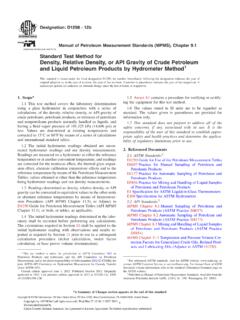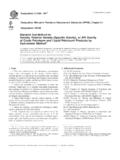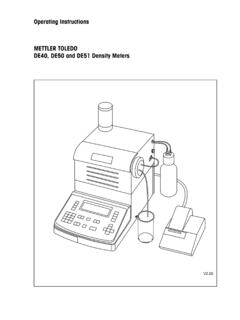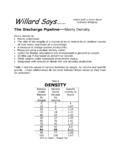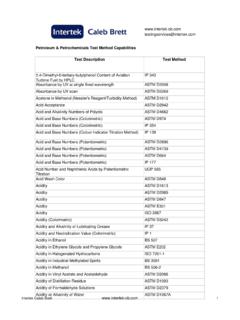Transcription of Scenarios for Clinicians Breast Density Notification Law ...
1 Breast Density , Breast Cancer Risk, and California Breast Density Notification Law SB 1538: Scenarios for Clinicians California Breast Density Information Group (CBDIG). March 2013. California Breast Density Information Group (CBDIG). A working group of Breast radiologists and Breast cancer risk specialists, representing academic and community-based practices across California Formed to assist patients, referring doctors, and radiologists in responding to new legislation in California (SB-1538) that will mandate radiologists report Breast Density to patients California Breast Density Information Group (CBDIG). Stanford University School of Medicine University of California, San Francisco Debra M. Ikeda, MD Bonnie N. Joe, MD PhD. Jafi A. Lipson, MD Edward A Sickles, MD. Bruce , MD Elissa R. Price, MD. Allison Kurian, MD MSc Lauren Ryan, MS LCGC. University of California, Davis University of California, Los Angeles Karen K.
2 Lindfors, MD Lawrence Bassett, MD. Jonathan Hargreaves, MD. Donna D. Walgenbach, MS CGC Alta-Bates Summit Medical Center Elyse Love, MS CGC R. James Brenner, MD JD. University of California, Irvine California Pacific Medical Center Stephen Feig, MD Jessica W. T. Leung, MD. University of California, San Diego Haydee Ojeda-Fournier, MD. My patient received the letter stating she has dense breasts. Now she is wondering whether she should continue to get mammograms at all. She should continue to get screening mammograms. The Breast Density law does not reflect any change in the current mammography screening recommendations by professional medical societies. Mammograms have been shown to be effective in lowering Breast cancer mortality for all Breast densities. My patient received the new Breast Density letter. She is concerned because she now thinks she is at high risk for Breast cancer.
3 Reassure the patient that Breast Density alone has only a small impact on Breast cancer risk. She wants to know specifically how it changes her risk. Look up her mammogram report (different from the patient letter). 1. If the report states her Density is heterogeneously dense, this is associated with minimal risk above average (RR= compared to average Breast Density ). 2. her If her Density densityis extremely is extremely dense dense, (also thissometimes factor doubles calledher simply risk of dense), breastthis cancer factor compared doubles her to risk average of Breast Density , cancer similar compared to the risk to average associated Density , with similar a familytohistory the risk of associated unilateral,with post-menopausal a family history Breast of Breast cancer cancerin ainmother, a mother, sister, sister, or daughter. or example, having extremely dense tissue on its own raises the 10-year risk of Breast cancer in the average 50 year old woman from 1 in 42 to 1 in 21.
4 My patient received the new Breast Density letter. She wants to be screened with another modality instead of mammograms. Explain that at this point in time, there is no other method that is recommended to replace the mammogram. There are certain manifestations of cancer (for example, calcifications) that are only seen on mammography. The other screening options referred to in the letter are in addition to, and not instead of, a routine screening mammogram. My patient received the new Breast Density letter. She wants to get additional tests to be screened for Breast cancer. Does she have a first degree relative (mother, She would likely benefit from a Breast cancer sister, daughter) who had premenopausal risk assessment. YES. Breast or ovarian cancer, or a male relative with Breast cancer? This could be performed by a physician with or experience in Breast cancer risk model Does she have a history of atypia (ADH, ALH) or selection and interpretation, or by a cancer risk LCIS on a previous Breast biopsy?
5 Assessment program. NO. If the patient does not have other Breast cancer risk factors, reassure her that her risk remains low. Educate the patient about the risks and benefits of screening MRI and ultrasound (higher cancer detection, but also higher false positive biopsy rates and short term follow-up recommendations). Many health centers have chosen not to offer screening Breast ultrasound, in part because ultrasound depicts many fewer mammographically invisible cancers than does screening MRI. Tomosynthesis is an additional screening test with current results suggesting some increase in cancer detection and decreased false positives. Explain that at most medical centers, additional screening tests are an out-of-pocket cost for the patient, unless they have been assessed to have high risk. Assist the patient in making the best personal choice to meet her needs based on these factors, using a shared decision making process.
6 My patient has heterogeneously dense . or extremely dense breasts and she also has other risk factors. She has completed a risk assessment showing her overall risk to be high ( calculated >20% lifetime risk or >5% 10-year risk), or has a BRCA. mutation or history of mantle radiation. Recommend annual Breast MRI and annual mammogram for screening. Screening Breast MRI is typically covered by insurance for high-risk women. If a woman is being screened annually with MRI. and mammogram, no additional screening tests (such as ultrasound) are needed. My patient has heterogeneously dense or extremely dense breasts and she also has other risk factors. She has completed a risk assessment showing her overall risk to be high ( calculated >20% lifetime risk or >5% 10-year risk). I recommended an annual MRI, but the patient has either claustrophobia, pacemaker, contrast allergy, limited insurance coverage plan, or other reasons why she does not want to have an MRI.
7 Recommend screening ultrasound as the second-best supplementary screening test for high risk women. Studies have shown some utility for ultrasound in high risk women if screening MRI is not performed. References American College of Radiology. Breast Imaging Reporting and Data System (BI-RADS ) 5. Reston, Va: American College of Radiology; Anticipated 2013. Berg WA, Blume JD, Cormack JB, et al. Combined screening with ultrasound and mammography vs mammography alone in women at elevated risk of Breast cancer. JAMA : the journal of the American Medical Association 2008;299:2151-63. Berg WA, Zhang Z, Lehrer D, et al. Detection of Breast cancer with addition of annual screening ultrasound or a single screening MRI. to mammography in women with elevated Breast cancer risk. JAMA : the journal of the American Medical Association 2012;307: 1394-404. Bevers TB, Anderson BO, Bonaccio E, et al.
8 NCCN clinical practice guidelines in oncology: Breast cancer screening and diagnosis. Journal of the National Comprehensive Cancer Network : JNCCN 2009;7(10):1060-96. Boyd NF, Guo H, Martin LJ, et al. Mammographic Density and the risk and detection of Breast cancer. The New England journal of medicine 2007;356:227-36. Buist DS, Porter PL, Lehman C, Taplin SH, White E. Factors contributing to mammography failure in women aged 40-49 years. Journal of the National Cancer Institute 2004;96:1432-40. Carney PA, Miglioretti DL, Yankaskas BC, et al. Individual and combined effects of age, Breast Density , and hormone replacement therapy use on the accuracy of screening mammography. Annals of internal medicine 2003;138:168-75. Hooley RJ, Greenberg KL, Stackhouse RM, Geisel JL, Butler RS, Philpotts LE. Screening US in patients with mammographically dense breasts: initial experience with Connecticut Public Act 09-41.
9 Radiology 2012;265:59-69. Kelly KM, Dean J, Comulada WS, Lee SJ. Breast cancer detection using automated whole Breast ultrasound and mammography in radiographically dense breasts. European radiology 2010;20:734-42. Kuhl C, Weigel S, Schrading S, et al. Prospective multicenter cohort study to refine management recommendations for women at elevated familial risk of Breast cancer: the EVA trial. Journal of clinical oncology : official journal of the American Society of Clinical Oncology 2010;28:1450-7. References Mainiero MB, Lourenco A, Mahoney MC, et al. ACR Appropriateness Criteria Breast Cancer Screening. Journal of the American College of Radiology : JACR 2013;10:11-4. Pinsky RW, Helvie MA. Mammographic Breast Density : effect on imaging and Breast cancer risk. Journal of the National Comprehensive Cancer Network : JNCCN 2010;8:1157-64; quiz 65. Saslow D, Boetes C, Burke W, et al.
10 American Cancer Society guidelines for Breast screening with MRI as an adjunct to mammography. CA: a cancer journal for Clinicians . 2007;57(2):75-89. Schousboe JT, Kerlikowske K, Loh A, Cummings SR. Personalizing mammography by Breast Density and other risk factors for Breast cancer: analysis of health benefits and cost-effectiveness. Annals of internal medicine 2011;155:10-20. Sickles EA. The use of Breast imaging to screen women at high risk for cancer. Radiolgic clinics of North America 2010; 48:859-878. Skaane P, Bandos AI, Gullien RT, et al. Comparison of digital mammography alone and digital mammography plus tomosynthesis in a population-based screening program. Radiology 2013; Epub ahead of print. Smith RA, Brooks D, Cokkinides V, Saslow D, Brawley OW. Cancer screening in the United States, 2013. CA : A cancer journal for Clinicians 2013; Epub ahead of print. Tice JA, Cummings SR, Smith-Bindman R, Ichikawa L, Barlow WE, Kerlikowske K.


